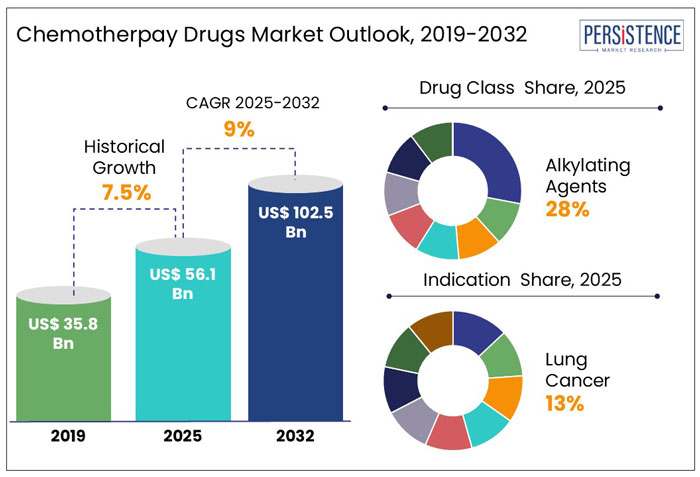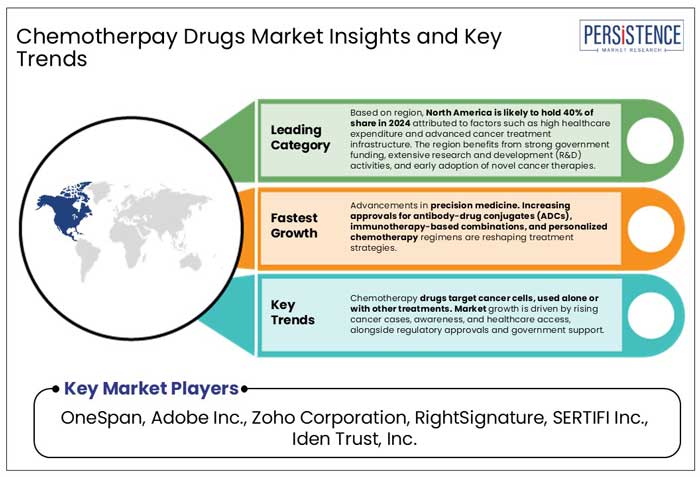ID: PMRREP27301| 278 Pages | 22 Nov 2022 | Format: PDF, Excel, PPT* | Healthcare

According to Persistence Market Research, the global Chemotherapy Drugs market will grow from its market size of US$ 56.1 Bn in 2025 to US$ 102.5 Bn in 2032, with a CAGR of 9.0% during the same period.
Chemotherapy drugs are used to destroy or slow the growth of cancer cells, either alone or alongside surgery, radiation, or immunotherapy. The market is expected to grow due to rising cancer prevalence, increased awareness, and better healthcare access. Key drivers include the increased regulatory approvals and government initiatives for chemotherapy drugs.
A significant trend is the shift towards oral chemotherapy and biologically targeted therapies, which offer greater convenience and tolerability. The rise of biosimilars also makes treatment more affordable in developing regions. With ongoing technological advancements and R&D, the chemotherapy drugs market is set for steady growth, playing a vital role in global cancer treatment strategies. Worldwide sales of Chemotherapy Drugs account for approximately 21% share of the global oncology drugs market.
Key Highlights of the Chemotherapy Drugs Industry
|
Estimated Market Value (2025E) |
US$ 56.1Bn |
|
Projected Market Value (2032F) |
US$ 102.5Bn |
|
Projected Growth (CAGR 2025 to 2032) |
9.0% |
|
Historical Market Growth (CAGR 2019 to 2024) |
7.5% |
The chemotherapy drugs market experienced an impressive compound annual growth rate (CAGR) of 7.5% from 2019 to 2024, primarily driven by the escalating global cancer crisis. This robust growth was further bolstered by expedited regulatory approvals and a significant post-pandemic recovery, leading to a rising demand for effective chemotherapy treatments.
According to the latest study by Persistence Market Research, the chemotherapy drugs market is projected to grow at an accelerated CAGR of 9.0% during 2025 to 2032, compared to the previous period. This surge in demand is primarily driven by increasing adoption of combination therapies, and advancements in personalized medicine.
The growing availability of biosimilar chemotherapy drugs and the shift towards oral chemotherapy for improved patient convenience are further fueling market expansion. Additionally, increased healthcare investments, especially in emerging economies, along with ongoing oncology research and AI-driven drug discovery, are expected to drive higher demand, ensuring strong market growth through 2032.

Regulatory Approvals & Government Initiatives Driving the Chemotherapy Drugs Market
The chemotherapy drugs market is significantly influenced by regulatory approvals and government initiatives, which accelerate the availability of innovative cancer treatments. In 2025, the FDA approved several oncology drugs, including brentuximab vedotin (Adcetris) with lenalidomide and rituximab for relapsed/refractory large B-cell lymphoma (LBCL), expanding chemotherapy options. Additionally, fam-trastuzumab deruxtecan-nxki (Enhertu) gained approval for HER2-low and HER2-ultralow breast cancer, reinforcing targeted approaches to enhance chemotherapy efficacy.
Government-led initiatives like NCI’s ComboMATCH program further support chemotherapy market growth by testing new drug combinations guided by tumor biology, integrating chemotherapy with precision medicine to improve treatment outcomes. These advancements, along with accelerated drug approvals and increased funding for oncology research, are driving the demand for chemotherapy drugs, ensuring wider access to innovative treatments in the coming years.
Severe Toxicity and Long-Term Health Risks Limiting Chemotherapy Adoption
The chemotherapy drugs market faces a significant challenge due to the severe side effects associated with treatment, which can impact patient adherence and influence the preference for alternative therapies. Common adverse effects include nausea, vomiting, anemia, and infections, often requiring additional medical intervention. Peripheral neuropathy from platinum-based chemotherapy can cause chronic pain and mobility issues, while cardiotoxicity increases the risk of heart failure, as seen in patients undergoing chemotherapy for breast cancer. Moreover, chemotherapy weakens the immune system, making patients vulnerable to severe infections, which can lead to prolonged hospital stays. In rare cases, chemotherapy has been linked to secondary cancers, raising long-term health concerns. These severe side effects drive research into less toxic alternatives such as targeted therapies and immunotherapy, posing a restraint on the chemotherapy drugs market.
Expansion of Biosimilars: A Game-Changer for the Chemotherapy Drugs Market
The rise of biosimilars is creating a transformative opportunity in the chemotherapy drugs market, offering significant cost savings and expanded patient access to essential treatments. According to research presented at the AMCP Nexus 2024 conference, biosimilars are demonstrating their potential to lower healthcare costs while maintaining treatment efficacy.
The increasing availability of biosimilar chemotherapy drugs presents a major opportunity to reduce treatment costs, improve patient access, and enhance affordability for healthcare systems. However, the actual market impact will depend on pricing strategies, provider adoption, and regulatory frameworks. With rising healthcare costs and increasing demand for cancer treatments, the expansion of biosimilars is set to redefine the chemotherapy drugs market, making high-quality cancer care more accessible worldwide.

Where Does North America Stand in the Global Market for Chemotherapy Drugs?
Chemotherapy Drugs demand in North America is anticipated to increase at 8.2% CAGR during the forecast period. United States is expected to hold a prominent share of the market through 2032.
North America remains the largest and most influential market for chemotherapy drugs, ensuring sustained demand and innovation in cancer treatment.
Where Does North America Stand in the Global Market for Chemotherapy Drugs?
Chemotherapy Drugs demand in North America is anticipated to increase at 8.2% CAGR during the forecast period. United States is expected to hold a prominent share of the market through 2032.
North America remains the largest and most influential market for chemotherapy drugs, ensuring sustained demand and innovation in cancer treatment.
Chemotherapy Drugs Market Outlook in Europe
The European chemotherapy drugs market is set to experience steady growth, driven by regulatory approvals and expanding treatment options, and is anticipated to expand at 7.0% value CAGR through 2032. With strong regulatory support, increased R&D investments, and a high cancer burden, Europe remains a key market for chemotherapy drugs, ensuring sustained demand in the coming years.
In December 2024, the European Commission approved dostarlimab plus chemotherapy for advanced or recurrent endometrial cancer, broadening chemotherapy’s role in cancer treatment.
Which Drug Class of Chemotherapy Drugs Remains the Most Significant?
Alkylating agents leads the market by grade and this segment is anticipated to grow at a CAGR of 8.6% through the forecast period.
These drugs work by damaging DNA and preventing cancer cell replication, making them highly effective in treating leukemias, lymphomas, and solid tumors such as breast, lung, and ovarian cancers. Alkylating agents, including cyclophosphamide, cisplatin, and ifosfamide, have been a cornerstone of chemotherapy for decades due to their strong cytotoxic effects and ability to work across different stages of cancer. Despite severe side effects, their high efficacy and versatility in combination therapy regimens ensure their continued dominance in the chemotherapy drug market.
Which Route of Administration Accounts for Higher Sales of Chemotherapy Drugs?
Oral Route dominate the global market and this segment is expected to hold its position until the end of the forecast period, growing at a CAGR of 8.4%, This shift is primarily due to the convenience and flexibility that oral chemotherapy offers, allowing patients to self-administer treatment at home without the need for intravenous (IV) infusions. Oral medications improve patient compliance and quality of life by reducing hospital visits and associated healthcare costs. However, it's important to note that the suitability of oral chemotherapy depends on the specific cancer type and individual patient factors, and not all chemotherapy treatments are available in oral form.
The chemotherapy drugs market is highly competitive, led by Roche, Pfizer, Novartis, Merck, Bristol-Myers Squibb, and Eli Lilly, focusing on innovation and oncology expansion. The rise of biosimilars, driven by patent expirations, is making chemotherapy more affordable, especially in emerging markets. Additionally, the shift toward combination therapies with immunotherapy and targeted treatments is intensifying competition, pushing companies to accelerate R&D and regulatory approvals to stay ahead.
Some of the key market developments are:
In February 11, 2025, the FDA approved mirdametinib (Gomekli, SpringWorks Therapeutics, Inc.), a kinase inhibitor, for the treatment of adult and pediatric patients (aged 2 years and older) with neurofibromatosis type 1 (NF1) who have symptomatic plexiform neurofibromas (PN) not amenable to complete resection. The approval marked a significant advancement in NF1 treatment, providing a targeted option for patients with limited surgical solutions.
The global chemotherapy drugs market stands at US$ 157.7 Bn in 2022.
Sales of chemotherapy drugs are set to witness high growth at a CAGR of 7.7% and reach US$ 331.3 Bn by 2032.
Demand for chemotherapy drugs increased at 6.4% CAGR from 2012 to 2021.
The U.S., Australia, Canada, Germany, and the U.K. account for the most demand for chemotherapy drugs, currently holding 59.6% market share.
The U.S. accounts for the largest share of the North American market, contributing revenue of around US$ 50.9 Bn.
Sanofi, Pfizer Inc., and Eli Lilly & Company are the top three manufacturers of chemotherapy drugs.
China held a share of 42.7% in the East Asia market in 2021, while Japan is estimated to grow at a CAGR of 7.4%.
Demand for chemotherapy medications in Europe accounted for 30.3% share of the global market in 2021.
Increased focus on enhancing drug efficacy, novel drug launches, and favorable regulatory scenarios are some of the key trends in this market.
The North American market is set to expand at a CAGR of 8.1% through 2032.
|
By Drug Class:
By Indication:
By Route of Administration:
By Dosage Form:
By Distribution Channel:
By Region:
Delivery Timelines
For more information on this report and its delivery timelines please get in touch with our sales team.
About Author